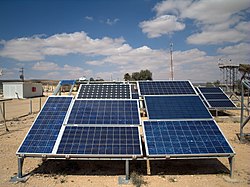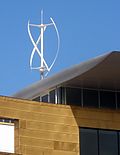Portal:Renewable energy
Introduction Renewable energy (also called green energy) is energy made from renewable natural resources that are replenished on a human timescale. The most widely used renewable energy types are solar energy, wind power, and hydropower. Bioenergy and geothermal power are also significant in some countries. Some also consider nuclear power a renewable power source, although this is controversial, as nuclear energy requires mining uranium, a nonrenewable resource. Renewable energy installations can be large or small and are suited for both urban and rural areas. Renewable energy is often deployed together with further electrification. This has several benefits: electricity can move heat and vehicles efficiently and is clean at the point of consumption. Variable renewable energy sources are those that have a fluctuating nature, such as wind power and solar power. In contrast, controllable renewable energy sources include dammed hydroelectricity, bioenergy, or geothermal power. Renewable energy systems have rapidly become more efficient and cheaper over the past 30 years. A large majority of worldwide newly installed electricity capacity is now renewable. Renewable energy sources, such as solar and wind power, have seen significant cost reductions over the past decade, making them more competitive with traditional fossil fuels. In most countries, photovoltaic solar or onshore wind are the cheapest new-build electricity. From 2011 to 2021, renewable energy grew from 20% to 28% of global electricity supply. Power from the sun and wind accounted for most of this increase, growing from a combined 2% to 10%. Use of fossil energy shrank from 68% to 62%. In 2024, renewables accounted for over 30% of global electricity generation and are projected to reach over 45% by 2030. Many countries already have renewables contributing more than 20% of their total energy supply, with some generating over half or even all their electricity from renewable sources. The main motivation to use renewable energy instead of fossil fuels is to slow and eventually stop climate change, which is mostly caused by their greenhouse gas emissions. In general, renewable energy sources pollute much less than fossil fuels. The International Energy Agency estimates that to achieve net zero emissions by 2050, 90% of global electricity will need to be generated by renewables. Renewables also cause much less air pollution than fossil fuels, improving public health, and are less noisy. The deployment of renewable energy still faces obstacles, especially fossil fuel subsidies, lobbying by incumbent power providers, and local opposition to the use of land for renewable installations. Like all mining, the extraction of minerals required for many renewable energy technologies also results in environmental damage. In addition, although most renewable energy sources are sustainable, some are not. (Full article...) Selected article - The use of solar energy began in Israel in the 1950s with the development by Levi Yissar of a solar water heater to address the energy shortages that plagued the new country. By 1967 around 5% of water of households were solar heated and 50,000 solar heaters had been sold. With the 1970s oil crisis, Harry Zvi Tabor developed the prototype of the solar water heater now used in over 90% of Israeli homes. There are over 1.3 million solar water heaters installed as a result of mandatory solar water heating regulations. Israeli engineers have been at the cutting edge of solar energy technology and its solar companies work on projects around the world. However, even though Israeli engineers have been involved in both photovoltaic and concentrated solar power, the earliest Israeli companies which have become market leaders in their respective fields have all been involved in concentrated solar power. Some notable examples of this are BrightSource, Solel and Brenmiller Energy which all deal with utility scale projects. Additionally, Herzliya based SolarEdge has become a market leader in inverters for non-utility scale photovoltaic solar power. In 2009, Israel found natural gas reserves within their exclusive economic zone which may reduce urgency of solar development. Solar technology in Israel has advanced to the point where it is almost cost-competitive with fossil fuels. The high annual incidence of sunshine in the Negev Desert has spurred an internationally renowned solar research and development industry. At the end of 2008, a feed-in tariff scheme was approved which has led to many residential and commercial solar energy power station projects. (Full article...) Quotations -
Main topicsRenewable energy sourcesGeneralRenewable energy commercialization · Smart grid · Timeline of sustainable energy research 2020–present Renewable energy by countryList of countries by electricity production from renewable sources
WikiProjectsWikiProjects connected with renewable energy: Selected image - Rapeseed field at Grendon, Northamptonshire. Rapeseed oil is used in the manufacture of biodiesel for powering motor vehicles. Selected biography -Hermann Scheer (29 April 1944 – 14 October 2010) was a Social Democrat member of the German Bundestag (parliament), President of Eurosolar (European Association for Renewable Energy) and General Chairman of the World Council for Renewable Energy. In 1999, Scheer was awarded the Right Livelihood Award for his "indefatigable work for the promotion of solar energy worldwide". Scheer believed that the continuation of current patterns of energy supply and use would be environmentally, socially, economically, and politically damaging, with renewable energy being the only realistic alternative. Scheer had concluded that it is technically and environmentally feasible to harness enough solar radiation to achieve a total replacement of the foclear (fossil/nuclear) energy system by a global renewable energy economy. The main obstacle to such a change is seen to be political, not technical or economic. In 1999 he was one of the initiators of the German feed-in tariffs that were the major source of the rise of renewable energies in Germany during the following years. (Full article...) Did you know? -... that efficient energy use is most often achieved by adopting a more efficient technology or production process ? Energy efficient buildings, industrial processes and transportation could reduce the world's energy needs in 2050 by one third, and help controlling global emissions of greenhouse gases, according to the International Energy Agency. Energy efficiency and renewable energy are said to be the twin pillars of sustainable energy policy. General images -The following are images from various renewable energy-related articles on Wikipedia.
Related portalsCategoriesAssociated WikimediaThe following Wikimedia Foundation sister projects provide more on this subject:
Discover Wikipedia using portals |





















![Image 17Concentrated solar panels are getting a power boost. Pacific Northwest National Laboratory (PNNL) will be testing a new concentrated solar power system – one that can help natural gas power plants reduce their fuel usage by up to 20 percent.[needs update] (from Solar energy)](https://upload.wikimedia.org/wikipedia/commons/thumb/8/82/Photo_of_the_Week-_Boosting_Solar_Technology_%288722948189%29.jpg/120px-Photo_of_the_Week-_Boosting_Solar_Technology_%288722948189%29.jpg)




























































